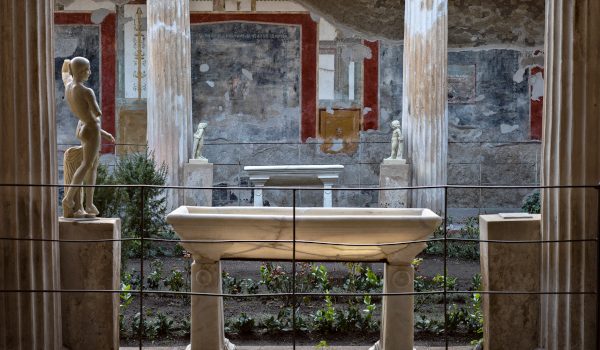THE HOUSE OF THE VETTII reopens to the public after 20 years: stunning beauty and crude reality in the iconic house of Pompeii
The House of the Vettii, the iconic house of Pompeii, is reopening. It is always included in guides to the UNESCO World Heritage site and books on ancient art as a result of its extraordinary frescoes and the sculptures that adorned the large garden.
After a period of closure lasting twenty years with a partial reopening in 2016 – confined to the entrance of the atrium and surrounding areas – visitors will finally be able to admire the House of the Vettii in all its architectural complexity as a result of recent restoration work.
The new restoration project, which began in 2016 under the direction of Massimo Osanna, has involved a wide range of professionals including archaeologists, architects, restorers, engineers, structural engineers and experts on gardening.
It stands out as one of the most complex archaeological heritage restoration projects of the last few decades. It has proved particularly difficult to remove the layers of wax applied to the frescoes in the past with the intention of protecting and enhancing them. Unfortunately, this restoration method has proved to be extremely harmful and has obscured many of the details of the elegant paintings, with depictions of fantastic architecture and mythological scenes.
The House of the Vettii has been closed to visitors for 20 years, with a brief interruption restricted to the entrance hall and the atrium in 2016, although this area was subsequently closed off again to enable the completion of the restoration work. It will now take its place once again as one of the highlights of a visit to Pompeii. The house has been included in the list of buildings that will remain open on a permanent basis to visitors in 2023.
The garden of the peristyle (colonnaded garden), which had a complex system of water channels and small fountains, has been restored with the inclusion of copies of the original statues, including a unique statue of its kind depicting Priapus, the god of fertility. The statues are kept in the display areas of the Archaeological Park. The garden also has ancient species of plants cultivated in the nursery within the Park as a part of a more wide-ranging project designed to enhance historic gardens and the cultivation of green areas of the ancient city through partnerships with local farmers and plant growers.
Excavated between 1894 and 1896, the House of the Vettii belonged to Aulus Vettius Conviva and Aulus Vettius Restitutus, probably two freedmen brothers who had become rich through commerce in wine. The magnificent paintings and sculptures in the house also reflect the wealth of the territory of Pompeii, where wine was produced for export throughout the Mediterranean, and social mobility which enabled two former slaves to reach the upper echelons of local society.
There are various traces of the life of the poor, in particular a room adjoining the kitchen in the slaves’ quarters which is decorated with small erotic paintings. The room was originally fitted with an iron door to ensure that access was restricted only to adult men. The barrier was removed only a few days prior to the re-opening of the house. It has been suggested that the room was used for prostitution, a hypothesis that appears to be confirmed by the discovery of an inscription on the left wall of the vestibulum (entrance hall). The inscription refers to a woman named Eutychis, “a Greek woman of pleasant manners”, who was offered for two asses (copper coins) (Eutychis Graeca a(ssibus) II moribus bellis). Besides the beauty of ancient art and architecture, this find offers an extraordinary insight into ancient society, its stratification and customs.
“This highly significant re-opening marks the end of a lengthy period of problematic restoration which in recent years has benefited from the successful model of the Large-scale European Project, both in terms of the management of funding and human resources, but with the difference that in this case everything has been run by the Park’s own staff, from the planning stage to the interventions,” stated the Director General of Museums, Massimo Osanna. “It is a crucial step that confirms the autonomy and success of the day-to-day management of Pompeii, a model that has gained international recognition”
"The House of the Vettii represents the story of the Roman world encapsulated in a single house, the ‘house/ museum’ of the ‘Roman spirit’: it contains mythological frescoes and sculptures made of bronze and marble of exceptional artistic quality which reflect the complex relationship between Greek models and Roman copies, as well as the economic and social life of the city. The owners, who were freedmen and thus former slaves, testify to a level of social mobility which would have been unthinkable two centuries previously. Their wealth stemmed from commerce in agricultural produce from the territory around Pompeii, but it would appear that prostitution was also practised in their house by a Greek slave woman who belonged to the most deprived groups of society,” emphasises Gabriel Zuchtriegel, Director of the Archaeological Park of Pompeii


